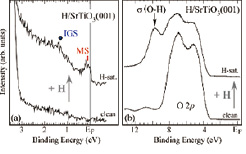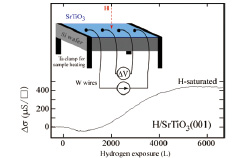Hydrogen-induced Surface Metallization of SrTiO3(001)
I. Matsuda Group
Transition-metal oxides, especially the perovskite-type, have been extensively studied in the past decades. Recently, their surface/interface systems have obtained great interests since the discovery of a two-dimensional electron gas (2DEG) at the interface of the two insulating oxides LaAlO3 and SrTiO3 [1]. It has been predicted by ab initio calculations that hydrogen adsorption on a SrO or TiO2 terminated SrTiO3(001) surface leads to a metallic state at the surface [2]. Such H-induced metallization was already reported for H/ZnO [3] crystal surfaces. In the case of SrTiO3 surface, the metallicity is assigned to the bulk band-bending near the surface, where the bulk conduction band is filled with electrons donated from the H atoms adsorbed on the surface. As hydrogen adsorption on a crystal surface prepared under UHV is a well-controlled procedure, experimental examination of the H-induced metallization of a SrTiO3(001) surface is thus strongly called for.

Fig. 1. Normal-emission photoemission spectra of the bare and the H-saturated SrTiO3(001) surfaces (a) at the Fermi level (EF) and (b) at the O 2p band. Spectra were taken at hν=81eV and at room temperature.

Fig. 2. Conductivity change, Δσ, with H exposure, referred to the conductivity of the clean surface. Measurements were performed at room temperature. (Inset) Schematic of four-terminal method transport measurements on the H/SrTiO3(001) surface.
In the present research[4], we examined the hydrogen-induced surface metallization on the H/SrTiO3(001) system. The electronic structure of the clean and H-adsorbed SrTiO3(001) surfaces is investigated by core-level and valence band photoemission spectroscopy measurements at the TEMPO beamline, SOLEIL, France, and SPring-8 BL07LSU[5]. Electrical conductivity is measured in situ during H-exposure by the four terminal method under UHV conditions with linearly aligned four probes. We found a dispersing metallic band and an increase of the surface conductivity after H adsorption. The metallic state (MS) is assigned to a quantized state in the space charge layer near the surface. The MS photoemission peak was associated with broad spectral features of the many-body effect. After the metallization, an electronic state in the bulk band gap (in-gap state, IGS) and a state, assigned to the O-H bond, were also observed. The measured two-dimensional (2-D) conductivity exceeds the 2-D Ioffe-Regel limit, indicating band conduction regime, and the mean free path of surface electrons is estimated to be several nm at room temperature.
References
- [1] A. Ohtomo, D. A. Muller, J. L. Grazul, and H. Y. Hwang, Nature 419, 378 (2002).
- [2] F. Lin, S. Wang, F. Zheng, G. Zhou, J. Wu, B.-L. Gu, and W. Duan, Phys. Rev. B 79, 035311 (2009).
- [3] K. Ozawa and K. Mase, Phys. Rev. B 81, 205322 (2010).
- [4] M. D’Angelo, R. Yukawa, K. Ozawa, S. Yamamoto, T. Hirahara, S. Hasegawa, M.G. Silly, F. Sirotti, and I. Matsuda, Phys. Rev. Lett. 108, 116802 (2012).
- [5]M. Ogawa, S. Yamamoto, Y. Kousa, F. Nakamura, R. Yukawa, A. Fukushima, A. Harasawa, H. Kondo, Y. Tanaka, A. Kakizaki, and I. Matsuda, Rev. Sci. Instrum. 83, 023109 (2012).
